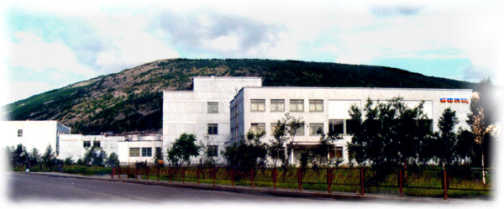MINISTRY OF SCIENCE AND HIGHER EDUCATION
OF THE RUSSIAN
FEDERATION
North-East Interdisciplinary Scientific
Research Institute
named after N.A. Shilo
Far
Eastern Branch of the Russian Academy of Sciences

The North-East Interdisciplinary Scientific Research Institute (NEISRI FEB RAS, Magadan), established in 1960, was the first academic institution founded in the North-East of Russia. Initially, its research focused on fundamental problems in geology, geophysics, history, archaeology, and socio-economic studies. Later, it expanded into cosmophysics and biological sciences. This laid the foundation for the development of academic science throughout the remote North-East of the country.
In 1972, the Institute of Biological Problems of the North (IBPN FEB RAS) was spun off from NEISRI, followed in 1984 by the Institute of Cosmophysical Research (IKIR), headquartered in Kamchatka.
By decree of the Presidium of the Supreme Soviet of the USSR dated May 29, 1981, NEISRI of the Far Eastern Scientific Center of the USSR Academy of Sciences was awarded the Order of the Badge of Honor for its achievements in scientific research and the training of scientific personnel.
The founder and first director of the institute was Academician Nikolay A. Shilo, after whom the institute was named in 2012.
Institute directors:
1960-1985: RAS Academician N.A. Shilo
1985-1994:
RAS Corresponding Member N.A. Sidorov
1994-2003:
RAS Academician V.I. Goncharov
2003-2017: RAS
Academician N.A. Goryachev
Since 2017: RAS
Corresponding Member V.V. Akinin
Main research areas include:
- Geology, geophysics, and geodynamics of continent-ocean transition zones in the North Pacific and Arctic regions
- Distribution patterns, geology, and genesis of mineral deposits in the Pacific mobile belt
- Cenozoic environmental evolution, current geodynamics, and geoecology
- History of the North-East of Russia from ancient times to the present
- Economic and social challenges of northern territories
As of 2024, the institute employs 129 people across five research laboratories, including a youth lab and a remote unit in Anadyr. Among them are 50 researchers: 1 RAS Academician, 1 RAS Corresponding Member, 8 Doctors of Sciences, and 27 Candidates of Sciences.
Key scientific achievements over the past 60 years include:
- The development of the theory of placer deposits
- Comprehensive studies in geology, mineralogy, and the genesis of solid mineral resources, with special focus on silver and gold deposits in Northeast Asia
- Participation in the compilation of tectonic, metallogenic, and geological maps of the region
- Reconstruction of the formation timeline and evolution of the continental crust along the margins of the Paleo-Pacific and Arctic
- Interpretation of global climate changes during the Late Neopleistocene and Holocene, including unique data on Arctic climate changes over the past 2.8 million years
- Numerous discoveries of archaeological sites and historical-ethnographic reconstructions
- Studies on spatial and structural transformations of socio-economic systems in the Russian Northeast
Ten researchers of the institute have been officially recognized as discoverers of mineral deposits.
Major fundamental research results of recent decades, published in leading scientific journals and monographs, include:
- The origin and age of the largest orogenic and magmatic belts in the Paleo-Pacific and Arctic, along with associated gold, silver, and copper deposits
- Models of Arctic origin, including reconstruction of the age and distribution of ancient continental crust in its eastern sector
- Stratigraphy and dating of Permian sedimentary basins in the North-East of Russia
- Climate and vegetation history during the Pleistocene, based on lake sediment analysis
- Reconstruction of population history and extinction dynamics of the woolly mammoth in northern Siberia
- Stages of early human settlement in northern Eurasia, based on archaeological and paleogenetic research
- Studies on the recent history and ethnography of the Russian North
- Analysis of socio-economic development in the Magadan Region and the dependence of regional development on natural resource assets and the age of foundational industries
Applied research conducted by the institute contributes to the socio-economic development of the Magadan Region and the Chukotka Autonomous Area. Major regional projects for mining and geological companies include forecasting and exploration strategies for precious metal and copper-porphyry mineralization in the Yano-Kolyma gold province and the Okhotsk-Chukotka volcanic belt, utilizing advanced analytical methods and innovative techniques.
The institute also performs geological and mineralogical assessments commissioned by regional and federal authorities, including engineering-geological and historical-cultural (archaeological) surveys of construction sites. It has documented key geological sites of the North-East of Russia and continues to explore new areas, particularly in protected territories.
A number of analytical reports have been prepared to support the inclusion of Magadan Region districts in the Arctic zone.
Institute researchers teach at the North-Eastern State University, the Magadan Polytechnic College, and the Anadyr branch of the North-Eastern Federal University in Yakutsk. They lead field geology courses, supervise graduate projects, and serve on state certification commissions.
Each year, researchers participate in the nationwide campaign "Week Without Turnstiles", organize traveling exhibitions from the institute's museum, and conduct career-oriented workshops for school students.
Supporting units at the institute include:
- The North-East Shared Analytical Center
- The Scientific Library
- The Museum of Natural History, which houses a unique collection of geological and archaeological specimens and is visited annually by thousands of residents and guests of Magadan
The institute publishes the "Bulletin of the North-East Scientific Center FEB RAS", which is included in the list of peer-reviewed journals and indexed in the Russian Science Citation Index (RSCI).
Notable members of the Russian Academy of Sciences who worked at the institute include:
Academician of the USSR Academy of Sciences N.A. Shilo -
founder and first director (1960-1985)
RAS Academician
V.I. Goncharov (1966-2004)
RAS Corresponding Member
A.A. Sidorov (1960-1993)
RAS Corresponding Member
N.N. Dikov (1960-1996)
RAS Academician K.V.
Simakov (1970-2004)
RAS Academician N.A.
Goryachev (1985-present) RAS Corresponding Member V.V.
Akinin (1982-present)
